Analysis of Low Energy Roofing Systems - Construction in Practice
VerifiedAdded on 2023/06/08
|14
|3215
|378
Report
AI Summary
This report provides a detailed analysis of low energy roofing systems, focusing on their application in construction practice. It examines three main types of roofing systems: Skylight Roofing Systems (SRS), Cool Roofs, and Green Roofs. For each system, the report discusses the advantages, disadvanta...
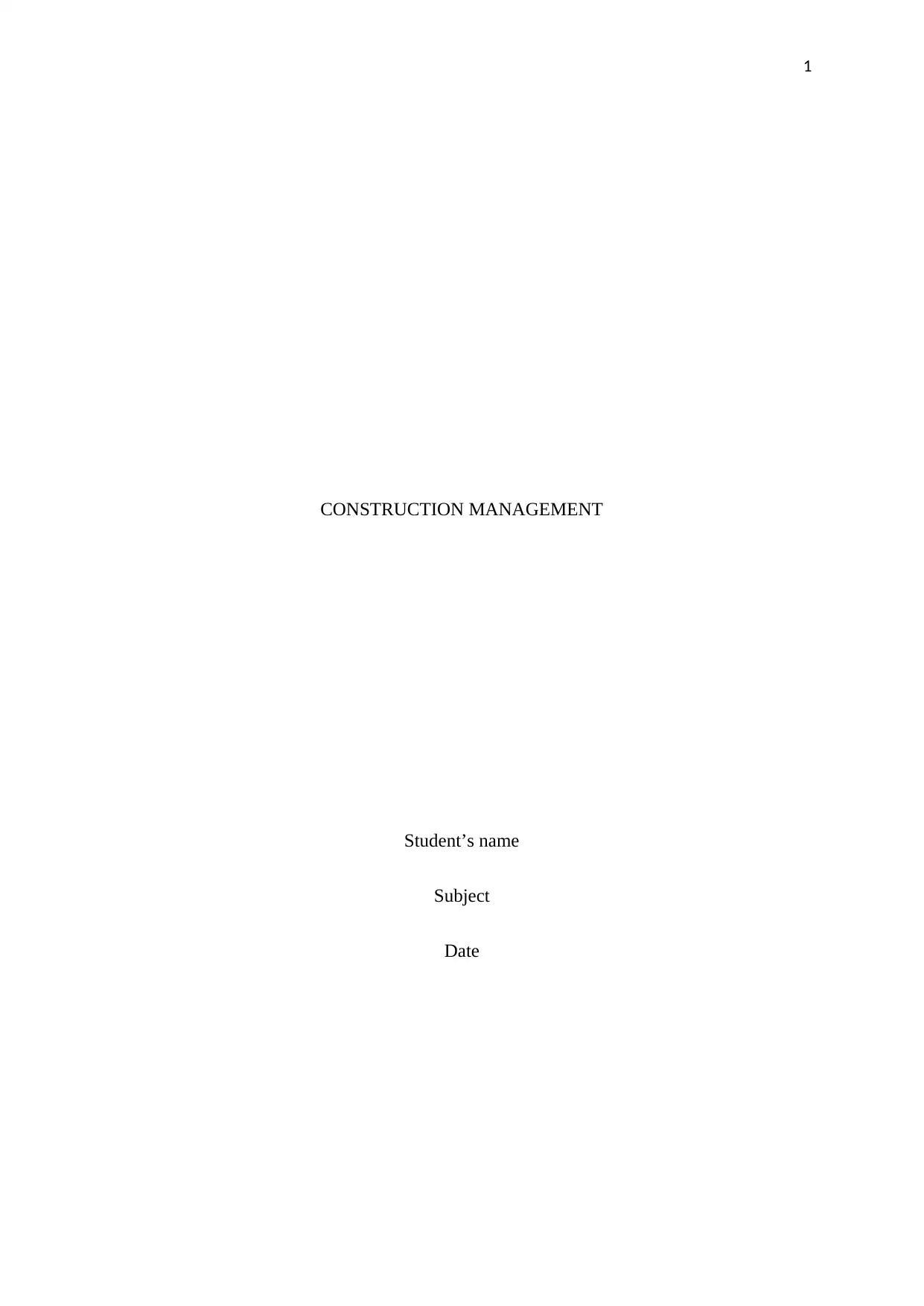
1
CONSTRUCTION MANAGEMENT
Student’s name
Subject
Date
CONSTRUCTION MANAGEMENT
Student’s name
Subject
Date
Paraphrase This Document
Need a fresh take? Get an instant paraphrase of this document with our AI Paraphraser

2
Contents
Introduction...........................................................................................................................................3
Fig 1. Theoretical load perception.....................................................................................................4
Systems..............................................................................................................................................4
Skylight Roofing System (SRS)....................................................................................................4
Advantages....................................................................................................................................5
Disadvantages................................................................................................................................5
Costs..............................................................................................................................................5
Cool Roofs............................................................................................................................................5
Costs..............................................................................................................................................6
Advantages and disadvantages......................................................................................................6
Green roof.............................................................................................................................................6
Costs..............................................................................................................................................7
Advantages....................................................................................................................................8
Disadvantages................................................................................................................................8
Environmental performance and technology improvement.............................................................8
Technological improvements to the environmental performance....................................................9
Conclusion...........................................................................................................................................10
Research recommendations.................................................................................................................10
References...........................................................................................................................................12
Contents
Introduction...........................................................................................................................................3
Fig 1. Theoretical load perception.....................................................................................................4
Systems..............................................................................................................................................4
Skylight Roofing System (SRS)....................................................................................................4
Advantages....................................................................................................................................5
Disadvantages................................................................................................................................5
Costs..............................................................................................................................................5
Cool Roofs............................................................................................................................................5
Costs..............................................................................................................................................6
Advantages and disadvantages......................................................................................................6
Green roof.............................................................................................................................................6
Costs..............................................................................................................................................7
Advantages....................................................................................................................................8
Disadvantages................................................................................................................................8
Environmental performance and technology improvement.............................................................8
Technological improvements to the environmental performance....................................................9
Conclusion...........................................................................................................................................10
Research recommendations.................................................................................................................10
References...........................................................................................................................................12
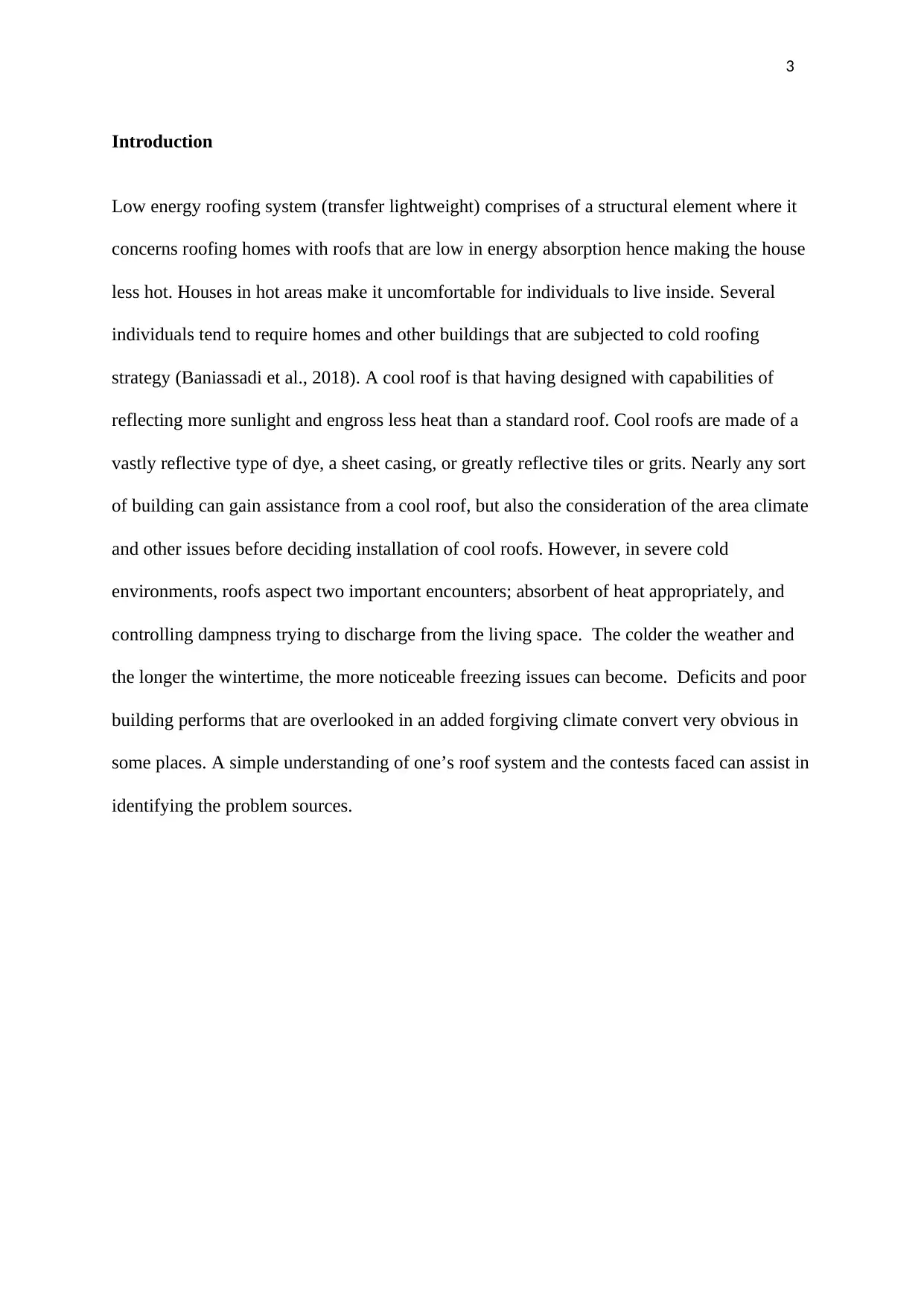
3
Introduction
Low energy roofing system (transfer lightweight) comprises of a structural element where it
concerns roofing homes with roofs that are low in energy absorption hence making the house
less hot. Houses in hot areas make it uncomfortable for individuals to live inside. Several
individuals tend to require homes and other buildings that are subjected to cold roofing
strategy (Baniassadi et al., 2018). A cool roof is that having designed with capabilities of
reflecting more sunlight and engross less heat than a standard roof. Cool roofs are made of a
vastly reflective type of dye, a sheet casing, or greatly reflective tiles or grits. Nearly any sort
of building can gain assistance from a cool roof, but also the consideration of the area climate
and other issues before deciding installation of cool roofs. However, in severe cold
environments, roofs aspect two important encounters; absorbent of heat appropriately, and
controlling dampness trying to discharge from the living space. The colder the weather and
the longer the wintertime, the more noticeable freezing issues can become. Deficits and poor
building performs that are overlooked in an added forgiving climate convert very obvious in
some places. A simple understanding of one’s roof system and the contests faced can assist in
identifying the problem sources.
Introduction
Low energy roofing system (transfer lightweight) comprises of a structural element where it
concerns roofing homes with roofs that are low in energy absorption hence making the house
less hot. Houses in hot areas make it uncomfortable for individuals to live inside. Several
individuals tend to require homes and other buildings that are subjected to cold roofing
strategy (Baniassadi et al., 2018). A cool roof is that having designed with capabilities of
reflecting more sunlight and engross less heat than a standard roof. Cool roofs are made of a
vastly reflective type of dye, a sheet casing, or greatly reflective tiles or grits. Nearly any sort
of building can gain assistance from a cool roof, but also the consideration of the area climate
and other issues before deciding installation of cool roofs. However, in severe cold
environments, roofs aspect two important encounters; absorbent of heat appropriately, and
controlling dampness trying to discharge from the living space. The colder the weather and
the longer the wintertime, the more noticeable freezing issues can become. Deficits and poor
building performs that are overlooked in an added forgiving climate convert very obvious in
some places. A simple understanding of one’s roof system and the contests faced can assist in
identifying the problem sources.
⊘ This is a preview!⊘
Do you want full access?
Subscribe today to unlock all pages.

Trusted by 1+ million students worldwide
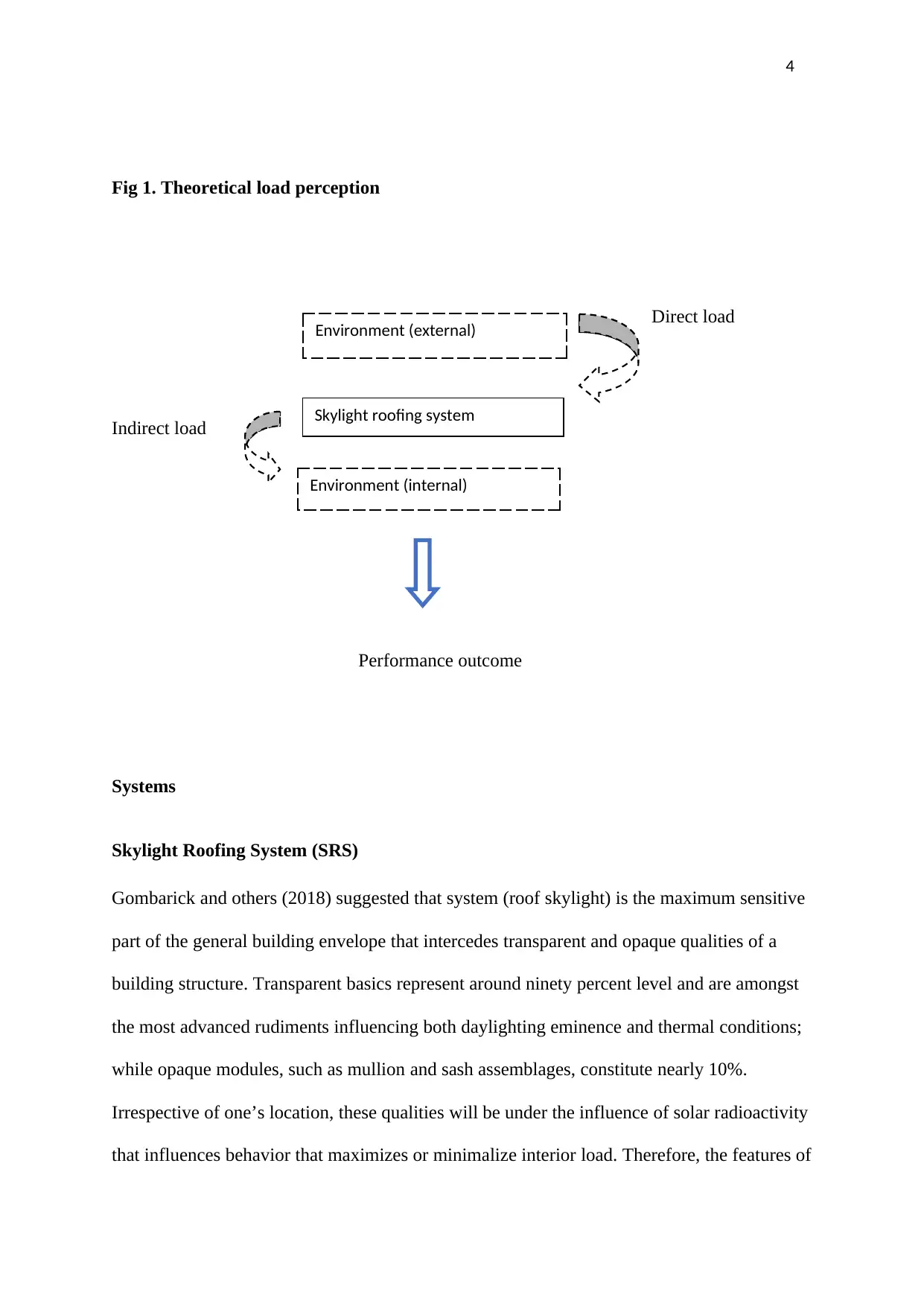
4
Fig 1. Theoretical load perception
Direct load
Indirect load
Performance outcome
Systems
Skylight Roofing System (SRS)
Gombarick and others (2018) suggested that system (roof skylight) is the maximum sensitive
part of the general building envelope that intercedes transparent and opaque qualities of a
building structure. Transparent basics represent around ninety percent level and are amongst
the most advanced rudiments influencing both daylighting eminence and thermal conditions;
while opaque modules, such as mullion and sash assemblages, constitute nearly 10%.
Irrespective of one’s location, these qualities will be under the influence of solar radioactivity
that influences behavior that maximizes or minimalize interior load. Therefore, the features of
Environment (external)
Skylight roofing system
Environment (internal)
Fig 1. Theoretical load perception
Direct load
Indirect load
Performance outcome
Systems
Skylight Roofing System (SRS)
Gombarick and others (2018) suggested that system (roof skylight) is the maximum sensitive
part of the general building envelope that intercedes transparent and opaque qualities of a
building structure. Transparent basics represent around ninety percent level and are amongst
the most advanced rudiments influencing both daylighting eminence and thermal conditions;
while opaque modules, such as mullion and sash assemblages, constitute nearly 10%.
Irrespective of one’s location, these qualities will be under the influence of solar radioactivity
that influences behavior that maximizes or minimalize interior load. Therefore, the features of
Environment (external)
Skylight roofing system
Environment (internal)
Paraphrase This Document
Need a fresh take? Get an instant paraphrase of this document with our AI Paraphraser

5
light and heat that intermingle in a roof skylight scheme and how these issues behave
ecologically should be deliberated and hence appropriately understood.
Advantages
The system is advantage in sense that is compatible with all roofing structures available. It is
easy to install them at all structural design thus no any time can look out of place.
Disadvantages
There is probable leakage in systems where roofing is not watertight. In cold times the
roofing cannot allow even small amount of energy to penetrate through the house.
Costs
The cost of installing skylights differs significantly depending on the type chosen, for
instance, existing roofing material used, and the structure gradient and other necessities.
Typically, this cost arrays in between $500-$3000.
Cool Roofs
Just as putting on light-colored clothing can assist in keeping one cool on a hot day, cool
roofs material premeditated to reflect more sunbeams and absorb less hotness than a standard
roof. According to Svetozarevic (2017) in the country, standard or dark roofs tend to achieve
temperatures of 150° degrees or extra in the summer sun whereas cool roof under the similar
conditions could stop more than 50° degrees cooler and exclude energy and money by
application of less air conditioning elements. The effect that roofs got on energy frequently
overlooked, the influence of which can be substantial. In winter, inadequate or damaged roof
protection permits heat to emit in the atmosphere readily. In midsummer, heat gained over the
roof upsurges not only the cooling consignment but also the top cooling load and in case of
light and heat that intermingle in a roof skylight scheme and how these issues behave
ecologically should be deliberated and hence appropriately understood.
Advantages
The system is advantage in sense that is compatible with all roofing structures available. It is
easy to install them at all structural design thus no any time can look out of place.
Disadvantages
There is probable leakage in systems where roofing is not watertight. In cold times the
roofing cannot allow even small amount of energy to penetrate through the house.
Costs
The cost of installing skylights differs significantly depending on the type chosen, for
instance, existing roofing material used, and the structure gradient and other necessities.
Typically, this cost arrays in between $500-$3000.
Cool Roofs
Just as putting on light-colored clothing can assist in keeping one cool on a hot day, cool
roofs material premeditated to reflect more sunbeams and absorb less hotness than a standard
roof. According to Svetozarevic (2017) in the country, standard or dark roofs tend to achieve
temperatures of 150° degrees or extra in the summer sun whereas cool roof under the similar
conditions could stop more than 50° degrees cooler and exclude energy and money by
application of less air conditioning elements. The effect that roofs got on energy frequently
overlooked, the influence of which can be substantial. In winter, inadequate or damaged roof
protection permits heat to emit in the atmosphere readily. In midsummer, heat gained over the
roof upsurges not only the cooling consignment but also the top cooling load and in case of
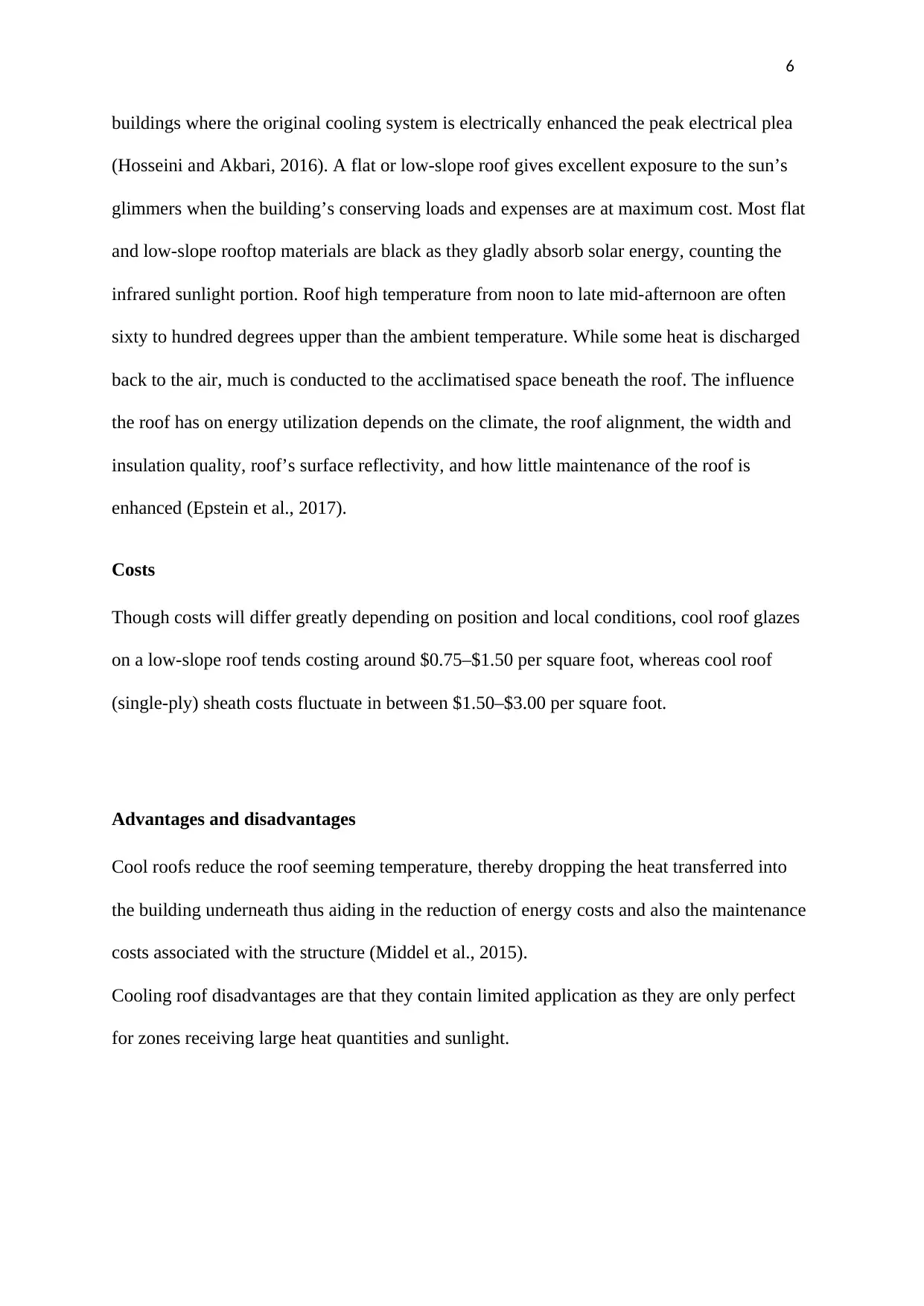
6
buildings where the original cooling system is electrically enhanced the peak electrical plea
(Hosseini and Akbari, 2016). A flat or low-slope roof gives excellent exposure to the sun’s
glimmers when the building’s conserving loads and expenses are at maximum cost. Most flat
and low-slope rooftop materials are black as they gladly absorb solar energy, counting the
infrared sunlight portion. Roof high temperature from noon to late mid-afternoon are often
sixty to hundred degrees upper than the ambient temperature. While some heat is discharged
back to the air, much is conducted to the acclimatised space beneath the roof. The influence
the roof has on energy utilization depends on the climate, the roof alignment, the width and
insulation quality, roof’s surface reflectivity, and how little maintenance of the roof is
enhanced (Epstein et al., 2017).
Costs
Though costs will differ greatly depending on position and local conditions, cool roof glazes
on a low-slope roof tends costing around $0.75–$1.50 per square foot, whereas cool roof
(single-ply) sheath costs fluctuate in between $1.50–$3.00 per square foot.
Advantages and disadvantages
Cool roofs reduce the roof seeming temperature, thereby dropping the heat transferred into
the building underneath thus aiding in the reduction of energy costs and also the maintenance
costs associated with the structure (Middel et al., 2015).
Cooling roof disadvantages are that they contain limited application as they are only perfect
for zones receiving large heat quantities and sunlight.
buildings where the original cooling system is electrically enhanced the peak electrical plea
(Hosseini and Akbari, 2016). A flat or low-slope roof gives excellent exposure to the sun’s
glimmers when the building’s conserving loads and expenses are at maximum cost. Most flat
and low-slope rooftop materials are black as they gladly absorb solar energy, counting the
infrared sunlight portion. Roof high temperature from noon to late mid-afternoon are often
sixty to hundred degrees upper than the ambient temperature. While some heat is discharged
back to the air, much is conducted to the acclimatised space beneath the roof. The influence
the roof has on energy utilization depends on the climate, the roof alignment, the width and
insulation quality, roof’s surface reflectivity, and how little maintenance of the roof is
enhanced (Epstein et al., 2017).
Costs
Though costs will differ greatly depending on position and local conditions, cool roof glazes
on a low-slope roof tends costing around $0.75–$1.50 per square foot, whereas cool roof
(single-ply) sheath costs fluctuate in between $1.50–$3.00 per square foot.
Advantages and disadvantages
Cool roofs reduce the roof seeming temperature, thereby dropping the heat transferred into
the building underneath thus aiding in the reduction of energy costs and also the maintenance
costs associated with the structure (Middel et al., 2015).
Cooling roof disadvantages are that they contain limited application as they are only perfect
for zones receiving large heat quantities and sunlight.
⊘ This is a preview!⊘
Do you want full access?
Subscribe today to unlock all pages.

Trusted by 1+ million students worldwide
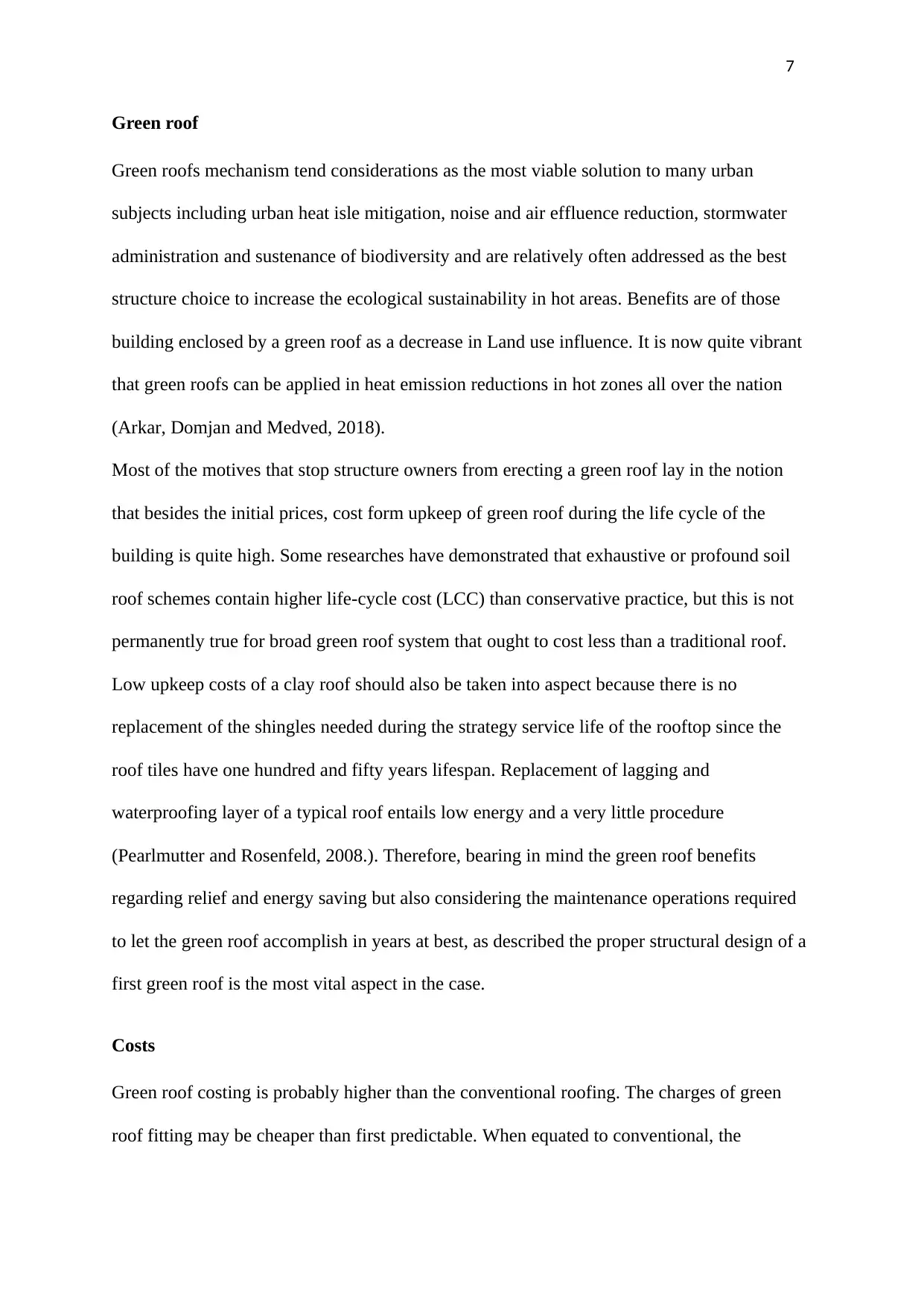
7
Green roof
Green roofs mechanism tend considerations as the most viable solution to many urban
subjects including urban heat isle mitigation, noise and air effluence reduction, stormwater
administration and sustenance of biodiversity and are relatively often addressed as the best
structure choice to increase the ecological sustainability in hot areas. Benefits are of those
building enclosed by a green roof as a decrease in Land use influence. It is now quite vibrant
that green roofs can be applied in heat emission reductions in hot zones all over the nation
(Arkar, Domjan and Medved, 2018).
Most of the motives that stop structure owners from erecting a green roof lay in the notion
that besides the initial prices, cost form upkeep of green roof during the life cycle of the
building is quite high. Some researches have demonstrated that exhaustive or profound soil
roof schemes contain higher life-cycle cost (LCC) than conservative practice, but this is not
permanently true for broad green roof system that ought to cost less than a traditional roof.
Low upkeep costs of a clay roof should also be taken into aspect because there is no
replacement of the shingles needed during the strategy service life of the rooftop since the
roof tiles have one hundred and fifty years lifespan. Replacement of lagging and
waterproofing layer of a typical roof entails low energy and a very little procedure
(Pearlmutter and Rosenfeld, 2008.). Therefore, bearing in mind the green roof benefits
regarding relief and energy saving but also considering the maintenance operations required
to let the green roof accomplish in years at best, as described the proper structural design of a
first green roof is the most vital aspect in the case.
Costs
Green roof costing is probably higher than the conventional roofing. The charges of green
roof fitting may be cheaper than first predictable. When equated to conventional, the
Green roof
Green roofs mechanism tend considerations as the most viable solution to many urban
subjects including urban heat isle mitigation, noise and air effluence reduction, stormwater
administration and sustenance of biodiversity and are relatively often addressed as the best
structure choice to increase the ecological sustainability in hot areas. Benefits are of those
building enclosed by a green roof as a decrease in Land use influence. It is now quite vibrant
that green roofs can be applied in heat emission reductions in hot zones all over the nation
(Arkar, Domjan and Medved, 2018).
Most of the motives that stop structure owners from erecting a green roof lay in the notion
that besides the initial prices, cost form upkeep of green roof during the life cycle of the
building is quite high. Some researches have demonstrated that exhaustive or profound soil
roof schemes contain higher life-cycle cost (LCC) than conservative practice, but this is not
permanently true for broad green roof system that ought to cost less than a traditional roof.
Low upkeep costs of a clay roof should also be taken into aspect because there is no
replacement of the shingles needed during the strategy service life of the rooftop since the
roof tiles have one hundred and fifty years lifespan. Replacement of lagging and
waterproofing layer of a typical roof entails low energy and a very little procedure
(Pearlmutter and Rosenfeld, 2008.). Therefore, bearing in mind the green roof benefits
regarding relief and energy saving but also considering the maintenance operations required
to let the green roof accomplish in years at best, as described the proper structural design of a
first green roof is the most vital aspect in the case.
Costs
Green roof costing is probably higher than the conventional roofing. The charges of green
roof fitting may be cheaper than first predictable. When equated to conventional, the
Paraphrase This Document
Need a fresh take? Get an instant paraphrase of this document with our AI Paraphraser
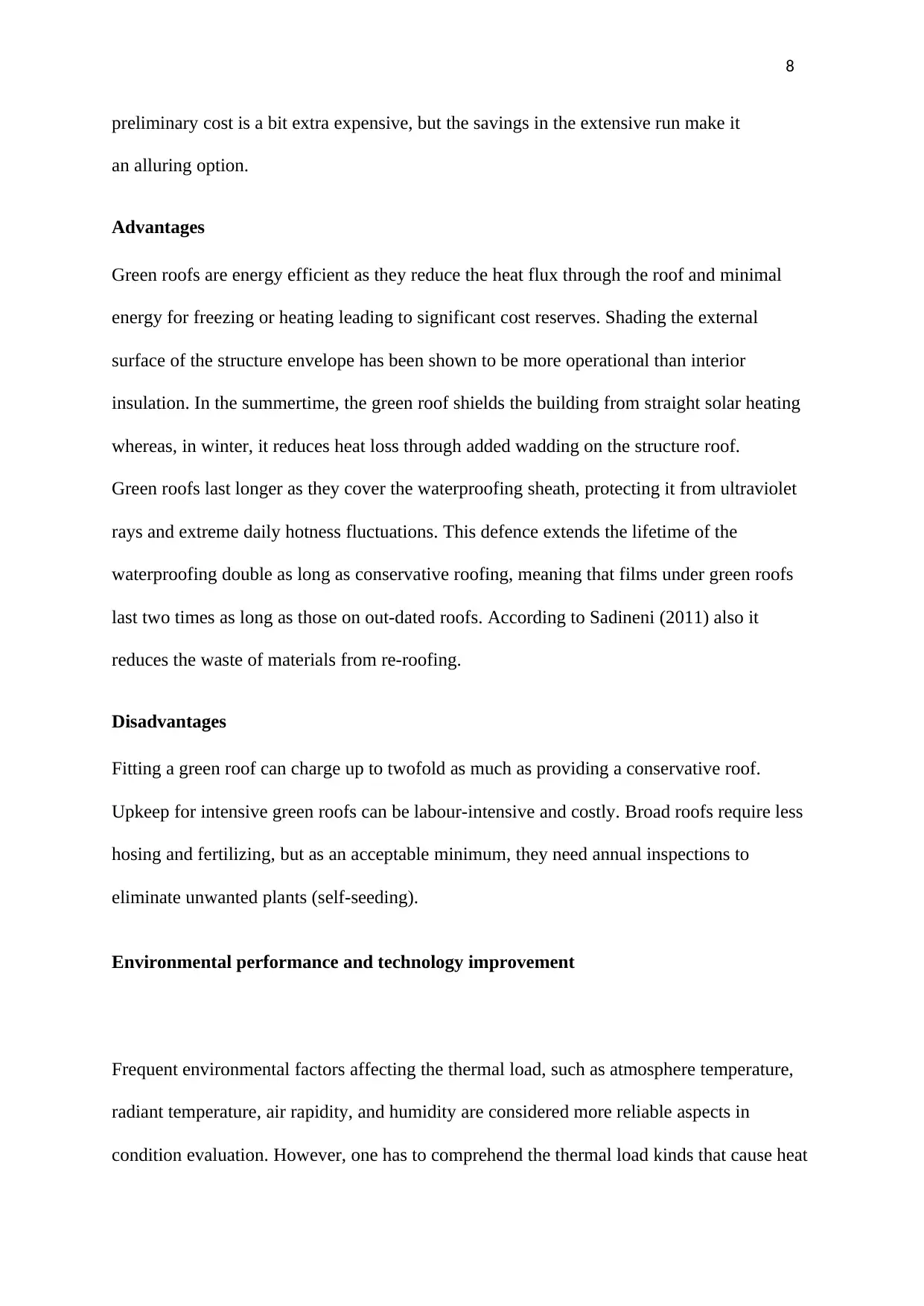
8
preliminary cost is a bit extra expensive, but the savings in the extensive run make it
an alluring option.
Advantages
Green roofs are energy efficient as they reduce the heat flux through the roof and minimal
energy for freezing or heating leading to significant cost reserves. Shading the external
surface of the structure envelope has been shown to be more operational than interior
insulation. In the summertime, the green roof shields the building from straight solar heating
whereas, in winter, it reduces heat loss through added wadding on the structure roof.
Green roofs last longer as they cover the waterproofing sheath, protecting it from ultraviolet
rays and extreme daily hotness fluctuations. This defence extends the lifetime of the
waterproofing double as long as conservative roofing, meaning that films under green roofs
last two times as long as those on out-dated roofs. According to Sadineni (2011) also it
reduces the waste of materials from re-roofing.
Disadvantages
Fitting a green roof can charge up to twofold as much as providing a conservative roof.
Upkeep for intensive green roofs can be labour-intensive and costly. Broad roofs require less
hosing and fertilizing, but as an acceptable minimum, they need annual inspections to
eliminate unwanted plants (self-seeding).
Environmental performance and technology improvement
Frequent environmental factors affecting the thermal load, such as atmosphere temperature,
radiant temperature, air rapidity, and humidity are considered more reliable aspects in
condition evaluation. However, one has to comprehend the thermal load kinds that cause heat
preliminary cost is a bit extra expensive, but the savings in the extensive run make it
an alluring option.
Advantages
Green roofs are energy efficient as they reduce the heat flux through the roof and minimal
energy for freezing or heating leading to significant cost reserves. Shading the external
surface of the structure envelope has been shown to be more operational than interior
insulation. In the summertime, the green roof shields the building from straight solar heating
whereas, in winter, it reduces heat loss through added wadding on the structure roof.
Green roofs last longer as they cover the waterproofing sheath, protecting it from ultraviolet
rays and extreme daily hotness fluctuations. This defence extends the lifetime of the
waterproofing double as long as conservative roofing, meaning that films under green roofs
last two times as long as those on out-dated roofs. According to Sadineni (2011) also it
reduces the waste of materials from re-roofing.
Disadvantages
Fitting a green roof can charge up to twofold as much as providing a conservative roof.
Upkeep for intensive green roofs can be labour-intensive and costly. Broad roofs require less
hosing and fertilizing, but as an acceptable minimum, they need annual inspections to
eliminate unwanted plants (self-seeding).
Environmental performance and technology improvement
Frequent environmental factors affecting the thermal load, such as atmosphere temperature,
radiant temperature, air rapidity, and humidity are considered more reliable aspects in
condition evaluation. However, one has to comprehend the thermal load kinds that cause heat

9
increases before stipulating the load capacity necessities where a study by Besir and Cuce
(2018) recognized six types of heat gains, individually,
• Conduction advances through the fabric.
• Indirect solar expansions from the sun on the opaque material (for instance, walls and
roof).
• Straight solar gains from the sun over the crystalline structure (openings and skylight).
• The aeriation gains from ventilation and air permeation (Gulati, Suddapalli and
Srinivasan, 2016).
• Interior gains from individuals and equipment in the area.
• Inter-zone gains from adjacent zones.
Technological improvements to the environmental performance
The technology of thermal break has upgraded, resulting in stronger resources that can accept
bigger triple-pane crystals thus reducing conductive hotness loss and refining performance.
According to Chemisana (2015) enhancements in IGU technology with low-e glazes and thin
flicks, high-efficiency bars or adjourned film glass aid in minimizing solar heat achievement
and deduct the U-value of coating systems. The process of reducing glare tends automation
by self-shading crystals, decreasing solar heat gain and accumulating comfort for individuals
using the building. Inventive application of these options pooled together with the innovative
design of the interior universe brings advance light into the building. Incorporating daylight
controls further bounds energy custom. In environmental performance, solar-integrated roof
shingles are a marked as a practical improvement over current technologies thus in the
construction of massive constructions it advisable to apply the technology as it will reduce
energy absorbing making the buildings hot. The research of Baniassadi, Heusinger and Sailor
increases before stipulating the load capacity necessities where a study by Besir and Cuce
(2018) recognized six types of heat gains, individually,
• Conduction advances through the fabric.
• Indirect solar expansions from the sun on the opaque material (for instance, walls and
roof).
• Straight solar gains from the sun over the crystalline structure (openings and skylight).
• The aeriation gains from ventilation and air permeation (Gulati, Suddapalli and
Srinivasan, 2016).
• Interior gains from individuals and equipment in the area.
• Inter-zone gains from adjacent zones.
Technological improvements to the environmental performance
The technology of thermal break has upgraded, resulting in stronger resources that can accept
bigger triple-pane crystals thus reducing conductive hotness loss and refining performance.
According to Chemisana (2015) enhancements in IGU technology with low-e glazes and thin
flicks, high-efficiency bars or adjourned film glass aid in minimizing solar heat achievement
and deduct the U-value of coating systems. The process of reducing glare tends automation
by self-shading crystals, decreasing solar heat gain and accumulating comfort for individuals
using the building. Inventive application of these options pooled together with the innovative
design of the interior universe brings advance light into the building. Incorporating daylight
controls further bounds energy custom. In environmental performance, solar-integrated roof
shingles are a marked as a practical improvement over current technologies thus in the
construction of massive constructions it advisable to apply the technology as it will reduce
energy absorbing making the buildings hot. The research of Baniassadi, Heusinger and Sailor
⊘ This is a preview!⊘
Do you want full access?
Subscribe today to unlock all pages.

Trusted by 1+ million students worldwide
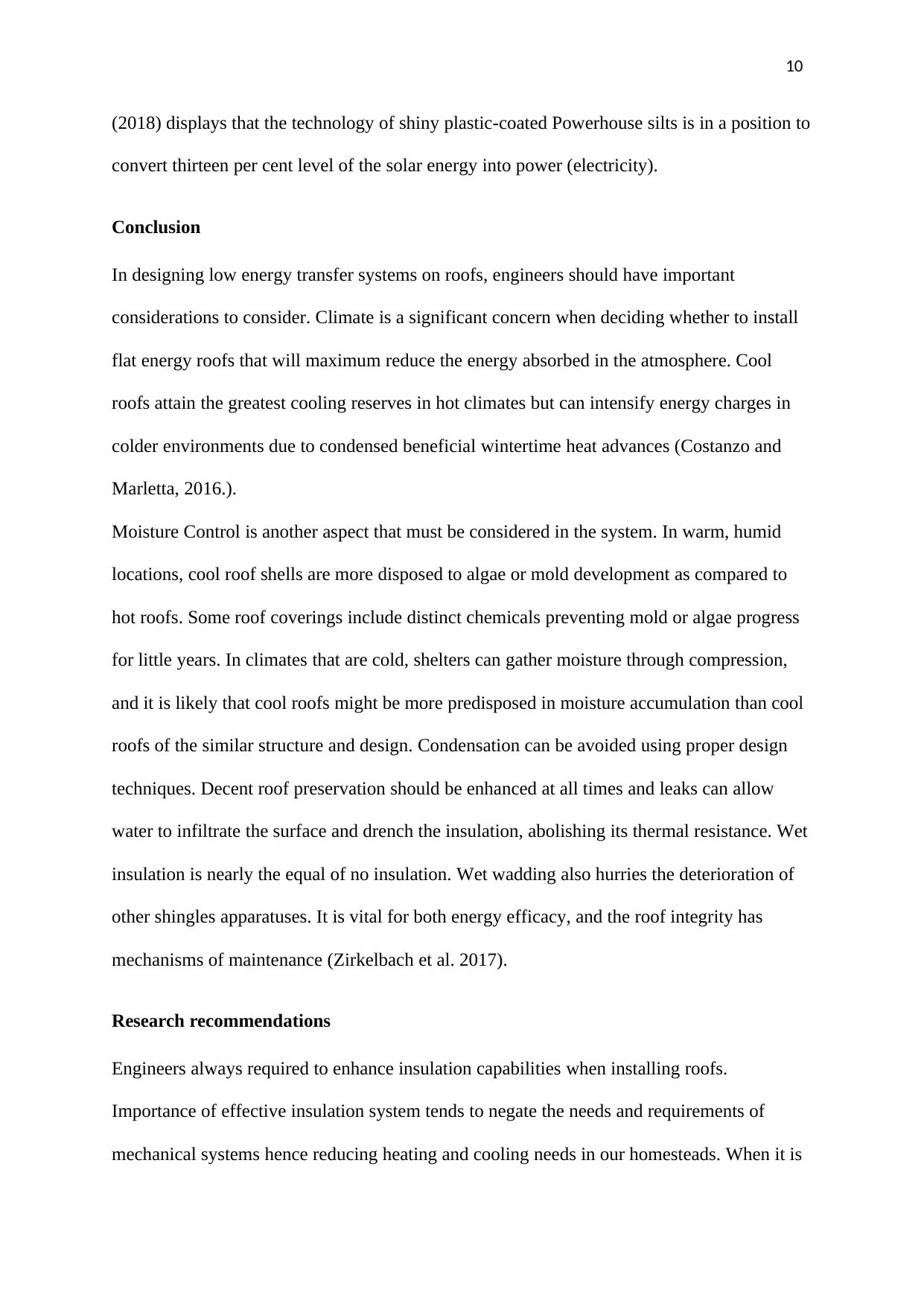
10
(2018) displays that the technology of shiny plastic-coated Powerhouse silts is in a position to
convert thirteen per cent level of the solar energy into power (electricity).
Conclusion
In designing low energy transfer systems on roofs, engineers should have important
considerations to consider. Climate is a significant concern when deciding whether to install
flat energy roofs that will maximum reduce the energy absorbed in the atmosphere. Cool
roofs attain the greatest cooling reserves in hot climates but can intensify energy charges in
colder environments due to condensed beneficial wintertime heat advances (Costanzo and
Marletta, 2016.).
Moisture Control is another aspect that must be considered in the system. In warm, humid
locations, cool roof shells are more disposed to algae or mold development as compared to
hot roofs. Some roof coverings include distinct chemicals preventing mold or algae progress
for little years. In climates that are cold, shelters can gather moisture through compression,
and it is likely that cool roofs might be more predisposed in moisture accumulation than cool
roofs of the similar structure and design. Condensation can be avoided using proper design
techniques. Decent roof preservation should be enhanced at all times and leaks can allow
water to infiltrate the surface and drench the insulation, abolishing its thermal resistance. Wet
insulation is nearly the equal of no insulation. Wet wadding also hurries the deterioration of
other shingles apparatuses. It is vital for both energy efficacy, and the roof integrity has
mechanisms of maintenance (Zirkelbach et al. 2017).
Research recommendations
Engineers always required to enhance insulation capabilities when installing roofs.
Importance of effective insulation system tends to negate the needs and requirements of
mechanical systems hence reducing heating and cooling needs in our homesteads. When it is
(2018) displays that the technology of shiny plastic-coated Powerhouse silts is in a position to
convert thirteen per cent level of the solar energy into power (electricity).
Conclusion
In designing low energy transfer systems on roofs, engineers should have important
considerations to consider. Climate is a significant concern when deciding whether to install
flat energy roofs that will maximum reduce the energy absorbed in the atmosphere. Cool
roofs attain the greatest cooling reserves in hot climates but can intensify energy charges in
colder environments due to condensed beneficial wintertime heat advances (Costanzo and
Marletta, 2016.).
Moisture Control is another aspect that must be considered in the system. In warm, humid
locations, cool roof shells are more disposed to algae or mold development as compared to
hot roofs. Some roof coverings include distinct chemicals preventing mold or algae progress
for little years. In climates that are cold, shelters can gather moisture through compression,
and it is likely that cool roofs might be more predisposed in moisture accumulation than cool
roofs of the similar structure and design. Condensation can be avoided using proper design
techniques. Decent roof preservation should be enhanced at all times and leaks can allow
water to infiltrate the surface and drench the insulation, abolishing its thermal resistance. Wet
insulation is nearly the equal of no insulation. Wet wadding also hurries the deterioration of
other shingles apparatuses. It is vital for both energy efficacy, and the roof integrity has
mechanisms of maintenance (Zirkelbach et al. 2017).
Research recommendations
Engineers always required to enhance insulation capabilities when installing roofs.
Importance of effective insulation system tends to negate the needs and requirements of
mechanical systems hence reducing heating and cooling needs in our homesteads. When it is
Paraphrase This Document
Need a fresh take? Get an instant paraphrase of this document with our AI Paraphraser
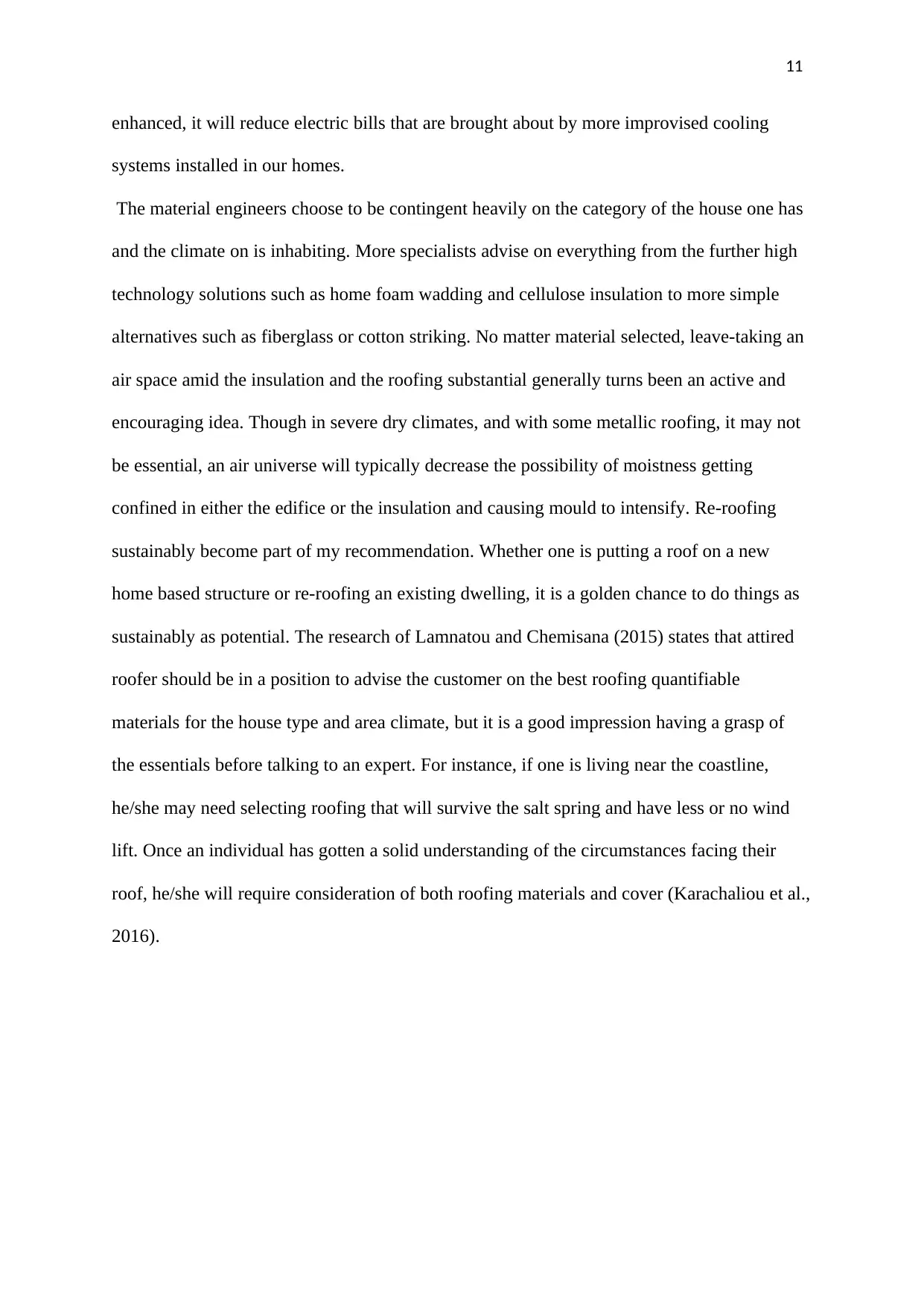
11
enhanced, it will reduce electric bills that are brought about by more improvised cooling
systems installed in our homes.
The material engineers choose to be contingent heavily on the category of the house one has
and the climate on is inhabiting. More specialists advise on everything from the further high
technology solutions such as home foam wadding and cellulose insulation to more simple
alternatives such as fiberglass or cotton striking. No matter material selected, leave-taking an
air space amid the insulation and the roofing substantial generally turns been an active and
encouraging idea. Though in severe dry climates, and with some metallic roofing, it may not
be essential, an air universe will typically decrease the possibility of moistness getting
confined in either the edifice or the insulation and causing mould to intensify. Re-roofing
sustainably become part of my recommendation. Whether one is putting a roof on a new
home based structure or re-roofing an existing dwelling, it is a golden chance to do things as
sustainably as potential. The research of Lamnatou and Chemisana (2015) states that attired
roofer should be in a position to advise the customer on the best roofing quantifiable
materials for the house type and area climate, but it is a good impression having a grasp of
the essentials before talking to an expert. For instance, if one is living near the coastline,
he/she may need selecting roofing that will survive the salt spring and have less or no wind
lift. Once an individual has gotten a solid understanding of the circumstances facing their
roof, he/she will require consideration of both roofing materials and cover (Karachaliou et al.,
2016).
enhanced, it will reduce electric bills that are brought about by more improvised cooling
systems installed in our homes.
The material engineers choose to be contingent heavily on the category of the house one has
and the climate on is inhabiting. More specialists advise on everything from the further high
technology solutions such as home foam wadding and cellulose insulation to more simple
alternatives such as fiberglass or cotton striking. No matter material selected, leave-taking an
air space amid the insulation and the roofing substantial generally turns been an active and
encouraging idea. Though in severe dry climates, and with some metallic roofing, it may not
be essential, an air universe will typically decrease the possibility of moistness getting
confined in either the edifice or the insulation and causing mould to intensify. Re-roofing
sustainably become part of my recommendation. Whether one is putting a roof on a new
home based structure or re-roofing an existing dwelling, it is a golden chance to do things as
sustainably as potential. The research of Lamnatou and Chemisana (2015) states that attired
roofer should be in a position to advise the customer on the best roofing quantifiable
materials for the house type and area climate, but it is a good impression having a grasp of
the essentials before talking to an expert. For instance, if one is living near the coastline,
he/she may need selecting roofing that will survive the salt spring and have less or no wind
lift. Once an individual has gotten a solid understanding of the circumstances facing their
roof, he/she will require consideration of both roofing materials and cover (Karachaliou et al.,
2016).

12
References
Arkar, C., Domjan, S. and Medved, S., 2018. Heat transfer in a lightweight extensive green
roof under water-freezing conditions. Energy and Buildings, 167, pp.187-199.
Baniassadi, A., Heusinger, J. and Sailor, D.J., 2018. Building energy savings potential of a
hybrid roofing system involving high albedo, moisture retaining foam materials. Energy and
Buildings, 169, pp.283-294.
Besir, A.B. and Cuce, E., 2018. Green roofs and facades: A comprehensive review.
Renewable and Sustainable Energy Reviews, 82, pp.915-939.
Castleton, H.F., Stovin, V., Beck, S.B. and Davison, J.B., 2010. Green roofs; building energy
savings and the potential for retrofit. Energy and buildings, 42(10), pp.1582-1591.
Costanzo, V., Evola, G. and Marletta, L., 2016. Energy savings in buildings or UHI
mitigation? Comparison between green roofs and cool roofs. Energy and buildings, 114,
pp.247-255.
Epstein, S.A., Lee, S.M., Katzenstein, A.S., Carreras-Sospedra, M., Zhang, X., Farina, S.C.,
Vahmani, P., Fine, P.M. and Ban-Weiss, G., 2017. Air-quality implications of widespread
adoption of cool roofs on ozone and particulate matter in southern California. Proceedings of
the National Academy of Sciences, 114(34), pp.8991-8996.
Gulati, R., Suddapalli, S. and Srinivasan, R.S., 2016, March. Energy Impacts of Roof
Fasteners for Metal Deck Roofing Systems during Re-roofing and Re-Cover Scenarios. In
Proceedings of the Roofing Consultants Institute (RCI) Conference, Orlando, FL, USA (Vol.
12).
Hosseini, M. and Akbari, H., 2016. Effect of cool roofs on commercial buildings energy use
in cold climates. Energy and Buildings, 114, pp.143-155.
References
Arkar, C., Domjan, S. and Medved, S., 2018. Heat transfer in a lightweight extensive green
roof under water-freezing conditions. Energy and Buildings, 167, pp.187-199.
Baniassadi, A., Heusinger, J. and Sailor, D.J., 2018. Building energy savings potential of a
hybrid roofing system involving high albedo, moisture retaining foam materials. Energy and
Buildings, 169, pp.283-294.
Besir, A.B. and Cuce, E., 2018. Green roofs and facades: A comprehensive review.
Renewable and Sustainable Energy Reviews, 82, pp.915-939.
Castleton, H.F., Stovin, V., Beck, S.B. and Davison, J.B., 2010. Green roofs; building energy
savings and the potential for retrofit. Energy and buildings, 42(10), pp.1582-1591.
Costanzo, V., Evola, G. and Marletta, L., 2016. Energy savings in buildings or UHI
mitigation? Comparison between green roofs and cool roofs. Energy and buildings, 114,
pp.247-255.
Epstein, S.A., Lee, S.M., Katzenstein, A.S., Carreras-Sospedra, M., Zhang, X., Farina, S.C.,
Vahmani, P., Fine, P.M. and Ban-Weiss, G., 2017. Air-quality implications of widespread
adoption of cool roofs on ozone and particulate matter in southern California. Proceedings of
the National Academy of Sciences, 114(34), pp.8991-8996.
Gulati, R., Suddapalli, S. and Srinivasan, R.S., 2016, March. Energy Impacts of Roof
Fasteners for Metal Deck Roofing Systems during Re-roofing and Re-Cover Scenarios. In
Proceedings of the Roofing Consultants Institute (RCI) Conference, Orlando, FL, USA (Vol.
12).
Hosseini, M. and Akbari, H., 2016. Effect of cool roofs on commercial buildings energy use
in cold climates. Energy and Buildings, 114, pp.143-155.
⊘ This is a preview!⊘
Do you want full access?
Subscribe today to unlock all pages.

Trusted by 1+ million students worldwide
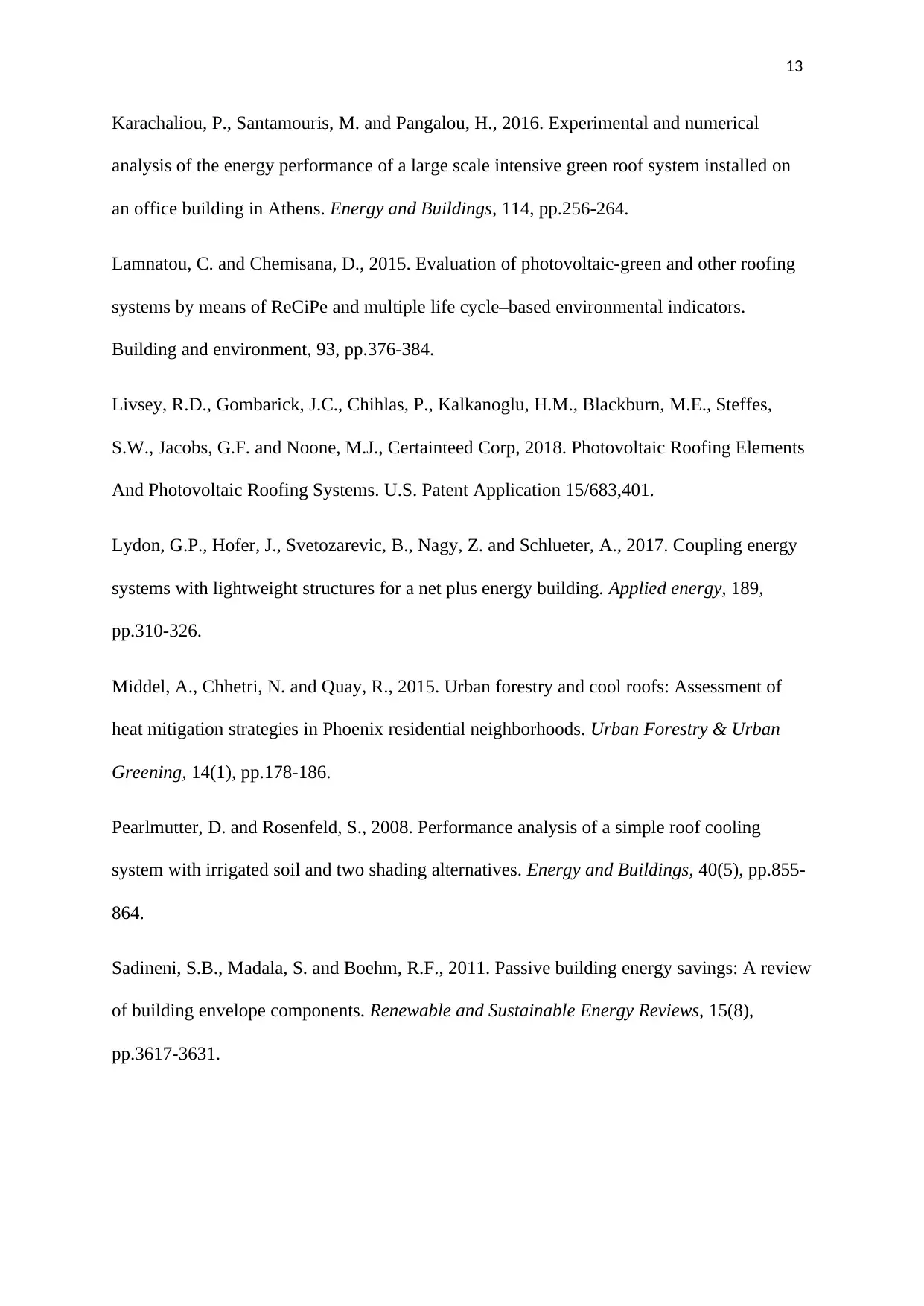
13
Karachaliou, P., Santamouris, M. and Pangalou, H., 2016. Experimental and numerical
analysis of the energy performance of a large scale intensive green roof system installed on
an office building in Athens. Energy and Buildings, 114, pp.256-264.
Lamnatou, C. and Chemisana, D., 2015. Evaluation of photovoltaic-green and other roofing
systems by means of ReCiPe and multiple life cycle–based environmental indicators.
Building and environment, 93, pp.376-384.
Livsey, R.D., Gombarick, J.C., Chihlas, P., Kalkanoglu, H.M., Blackburn, M.E., Steffes,
S.W., Jacobs, G.F. and Noone, M.J., Certainteed Corp, 2018. Photovoltaic Roofing Elements
And Photovoltaic Roofing Systems. U.S. Patent Application 15/683,401.
Lydon, G.P., Hofer, J., Svetozarevic, B., Nagy, Z. and Schlueter, A., 2017. Coupling energy
systems with lightweight structures for a net plus energy building. Applied energy, 189,
pp.310-326.
Middel, A., Chhetri, N. and Quay, R., 2015. Urban forestry and cool roofs: Assessment of
heat mitigation strategies in Phoenix residential neighborhoods. Urban Forestry & Urban
Greening, 14(1), pp.178-186.
Pearlmutter, D. and Rosenfeld, S., 2008. Performance analysis of a simple roof cooling
system with irrigated soil and two shading alternatives. Energy and Buildings, 40(5), pp.855-
864.
Sadineni, S.B., Madala, S. and Boehm, R.F., 2011. Passive building energy savings: A review
of building envelope components. Renewable and Sustainable Energy Reviews, 15(8),
pp.3617-3631.
Karachaliou, P., Santamouris, M. and Pangalou, H., 2016. Experimental and numerical
analysis of the energy performance of a large scale intensive green roof system installed on
an office building in Athens. Energy and Buildings, 114, pp.256-264.
Lamnatou, C. and Chemisana, D., 2015. Evaluation of photovoltaic-green and other roofing
systems by means of ReCiPe and multiple life cycle–based environmental indicators.
Building and environment, 93, pp.376-384.
Livsey, R.D., Gombarick, J.C., Chihlas, P., Kalkanoglu, H.M., Blackburn, M.E., Steffes,
S.W., Jacobs, G.F. and Noone, M.J., Certainteed Corp, 2018. Photovoltaic Roofing Elements
And Photovoltaic Roofing Systems. U.S. Patent Application 15/683,401.
Lydon, G.P., Hofer, J., Svetozarevic, B., Nagy, Z. and Schlueter, A., 2017. Coupling energy
systems with lightweight structures for a net plus energy building. Applied energy, 189,
pp.310-326.
Middel, A., Chhetri, N. and Quay, R., 2015. Urban forestry and cool roofs: Assessment of
heat mitigation strategies in Phoenix residential neighborhoods. Urban Forestry & Urban
Greening, 14(1), pp.178-186.
Pearlmutter, D. and Rosenfeld, S., 2008. Performance analysis of a simple roof cooling
system with irrigated soil and two shading alternatives. Energy and Buildings, 40(5), pp.855-
864.
Sadineni, S.B., Madala, S. and Boehm, R.F., 2011. Passive building energy savings: A review
of building envelope components. Renewable and Sustainable Energy Reviews, 15(8),
pp.3617-3631.
Paraphrase This Document
Need a fresh take? Get an instant paraphrase of this document with our AI Paraphraser
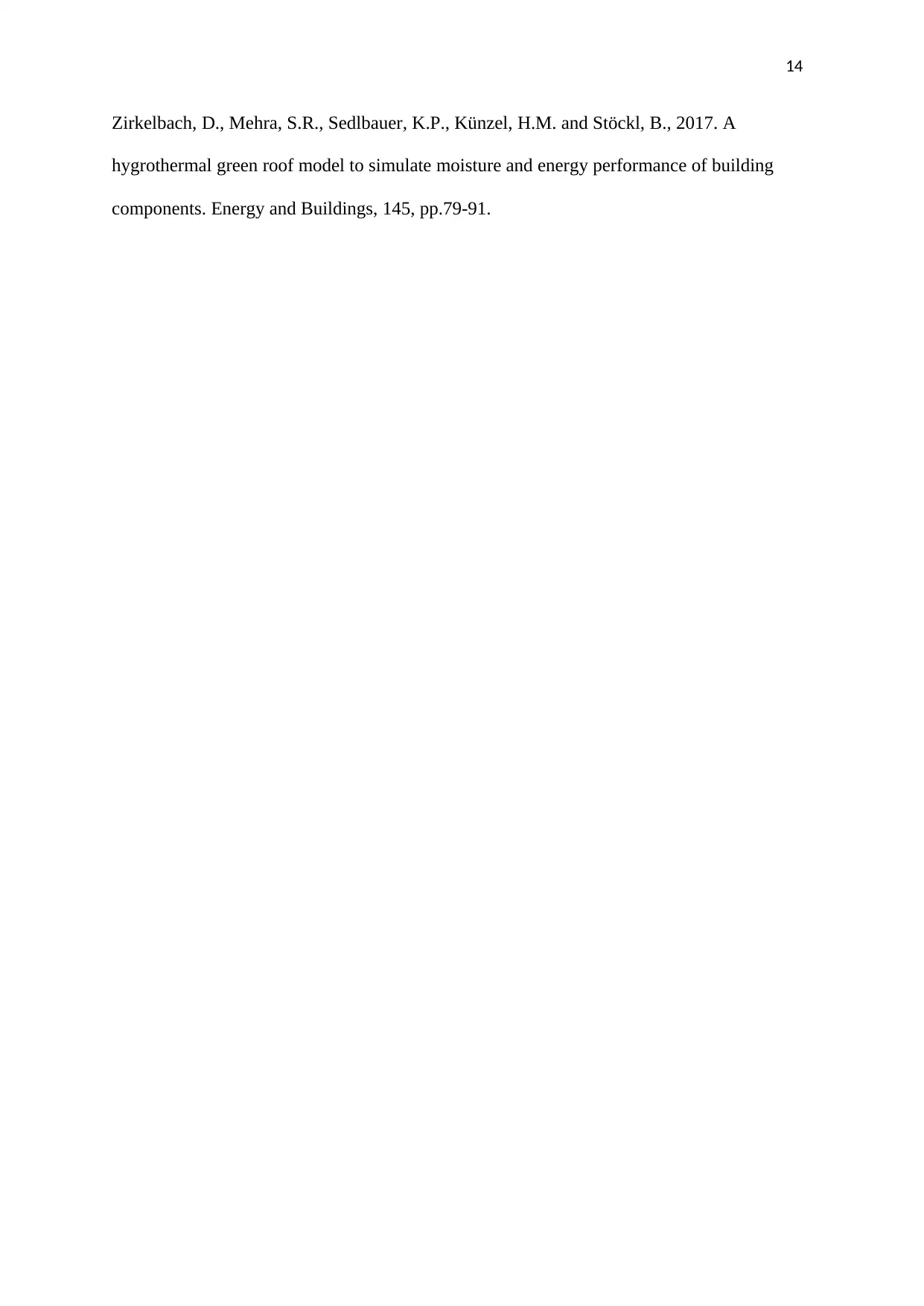
14
Zirkelbach, D., Mehra, S.R., Sedlbauer, K.P., Künzel, H.M. and Stöckl, B., 2017. A
hygrothermal green roof model to simulate moisture and energy performance of building
components. Energy and Buildings, 145, pp.79-91.
Zirkelbach, D., Mehra, S.R., Sedlbauer, K.P., Künzel, H.M. and Stöckl, B., 2017. A
hygrothermal green roof model to simulate moisture and energy performance of building
components. Energy and Buildings, 145, pp.79-91.
1 out of 14
Related Documents
Your All-in-One AI-Powered Toolkit for Academic Success.
+13062052269
info@desklib.com
Available 24*7 on WhatsApp / Email
![[object Object]](/_next/static/media/star-bottom.7253800d.svg)
Unlock your academic potential
© 2024 | Zucol Services PVT LTD | All rights reserved.





